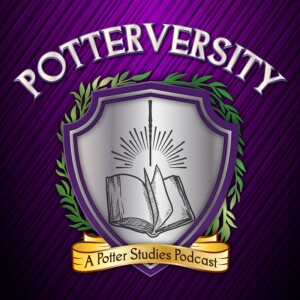
Potterversity: A Potter Studies Podcast
Arts:Books

We're starting off the companion episodes to our new book with the dark side of Harry Potter.
Dr. Beatrice Groves (Oxford University and Bathilda's Notebook) and Dr. Amy Strugis (Lenoir-Rhyne University and Signum University) join us to discuss their chapters "Good Men and Monsters: The Influence of Bram Stoker's Dracula on Harry Potter" and "Dark Arts and Secret Histories: Investigating Dark Academia." They talk about what drew them to the more disturbing and Gothic aspects of the series.
Amy explains the difference between the Dark Academia aesthetic and the literary genre. The latter generally involves a school or university setting, elements of mystery and death, concern with the past, and social critique, especially of power dynamics that exist in the wider world and are concentrated in an academic institution - all of which are present in Potter. It might seem like heavy material for young readers, but adolescents can experience bullying, injustice, and grief and can relate to and learn from fiction. The aesthetic that has been popularized online tends to focus purely on style, romanticizing some of what the genre criticizes.
Harry Potter engages with dark and Gothic traditions but also breaks from them. Bea sees Mina Harker in Dracula as a parallel for Harry, both marked by evil, but the works ultimately seem to have different attitudes toward the nature of evil - while Dracula's influence can turn innocent Mina into a monster, Harry maintains his inherent goodness and the power to resist Voldemort.
What problems does knowledge of the Dark Arts pose? Going back to Mary Shelley's Frankenstein, danger lies in how people use such knowledge more than the knowledge itself. Knowledge is power, so keeping secrets and controlling access to knowledge are issues in Dark Academia - a genre that has only become more popular since the success of Potter.
Dr. Beatrice Groves (Oxford University and Bathilda's Notebook) and Dr. Amy Strugis (Lenoir-Rhyne University and Signum University) join us to discuss their chapters "Good Men and Monsters: The Influence of Bram Stoker's Dracula on Harry Potter" and "Dark Arts and Secret Histories: Investigating Dark Academia." They talk about what drew them to the more disturbing and Gothic aspects of the series.
Amy explains the difference between the Dark Academia aesthetic and the literary genre. The latter generally involves a school or university setting, elements of mystery and death, concern with the past, and social critique, especially of power dynamics that exist in the wider world and are concentrated in an academic institution - all of which are present in Potter. It might seem like heavy material for young readers, but adolescents can experience bullying, injustice, and grief and can relate to and learn from fiction. The aesthetic that has been popularized online tends to focus purely on style, romanticizing some of what the genre criticizes.
Harry Potter engages with dark and Gothic traditions but also breaks from them. Bea sees Mina Harker in Dracula as a parallel for Harry, both marked by evil, but the works ultimately seem to have different attitudes toward the nature of evil - while Dracula's influence can turn innocent Mina into a monster, Harry maintains his inherent goodness and the power to resist Voldemort.
What problems does knowledge of the Dark Arts pose? Going back to Mary Shelley's Frankenstein, danger lies in how people use such knowledge more than the knowledge itself. Knowledge is power, so keeping secrets and controlling access to knowledge are issues in Dark Academia - a genre that has only become more popular since the success of Potter.
More Episodes
Potterversity Episode 17: Potter and the Pig
 2022-01-10
2022-01-10
 2022-01-10
2022-01-10
Potterversity Episode 14: Hogwarts Bullies
 2021-10-11
2021-10-11
 2021-10-11
2021-10-11
Potterversity Episode 11: Reading the Signs
 2021-07-12
2021-07-12
 2021-07-12
2021-07-12
Potterversity Episode 9: Harry Meets Dracula
 2021-05-10
2021-05-10
 2021-05-10
2021-05-10
Potterversity Episode 5: Uncle Vernon
 2021-02-08
2021-02-08
 2021-02-08
2021-02-08
Potterversity Episode 2: Good Trouble
 2020-11-30
2020-11-30
 2020-11-30
2020-11-30
Potterversity Episode 1: Orientation
 2020-10-31
2020-10-31
 2020-10-31
2020-10-31
Episode 46: A Bridge to Something Magical
 2020-09-28
2020-09-28
 2020-09-28
2020-09-28
012345678910111213141516171819
Create your
podcast in
minutes
- Full-featured podcast site
- Unlimited storage and bandwidth
- Comprehensive podcast stats
- Distribute to Apple Podcasts, Spotify, and more
- Make money with your podcast
It is Free
- Privacy Policy
- Cookie Policy
- Terms of Use
- Consent Preferences
- Copyright © 2015-2024 Podbean.com





